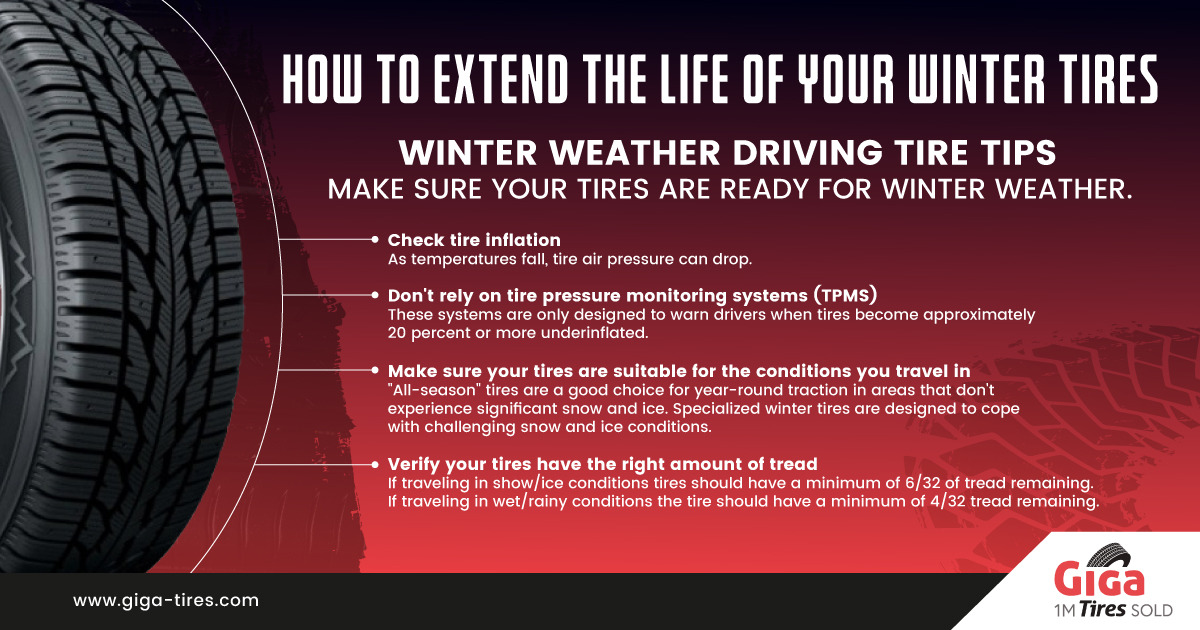Last Updated on 4 months
Complete Guide: How to Extend the Life of Your Winter Tires
Winter tires are your best friend when the weather gets tough. A great set of snow tires will guarantee your vehicle’s safety in harsh conditions and ensure optimal steering and handling. However, as sturdy and capable as winter tires are, they still require proper maintenance to perform flawlessly. A good set of winter tires can last several seasons when properly cared for. Today, we will share some valuable tips on how to maintain them.
Inspecting the Tires
Make a habit of regularly inspecting tires for uneven wear and cracks and measuring the tread depth. This information can provide valuable insight into the overall health of your tire and vehicle. For example, a brand-new set of winter tires typically has a tread depth of 10 or 11/32 of an inch. If your tread depth is below 4/32 of an inch, it is time for replacement. Also, if you notice uneven tread wear, that could indicate suspension or alignment issues.
Optimal Pressure
Cold weather can also cause tire pressure to drop significantly. It doesn’t mean your tires are bad; it’s just the result of low temperatures making the air inside the tire denser, reducing the pressure. However, that is why it is beneficial to check the tire pressure regularly and inflate the tire to the manufacturer’s specifications if needed. Underinflated tires are dangerous because they will not perform as they should, which leads to uneven wear and poor fuel economy. If your vehicle is not equipped with a tire pressure monitoring system (TPMS), you can check it manually, but always follow the recommended values and do not over-inflate the tires.
Rotation
Tire rotation is one of the key tire maintenance tips to improve performance and extend their life. Since front and rear tires wear differently, rotating them promotes even wear and prevents excessive wear in specific areas. The general rule is to rotate winter tires every 6,000 to 8,000 miles. Typically, winter tires follow a front-to-back or diagonal rotation pattern, depending on whether your car is front-wheel, rear-wheel, or all-wheel drive. Also, pay attention to vehicles with staggered wheel setups (where the rear tires are wider than the front); in those cases, you can rotate the tires on the same axle, not front to rear or vice versa.
Alignment and Balancing
Proper alignment and balancing are key to even wear and comfortable driving. Misaligned wheels can cause uneven tire wear, reducing your winter tires’ lifespan and negatively affecting your vehicle’s handling. Poor alignment often leads to wear on one side of the tire. On the other hand, unbalanced tires can cause vibrations, uneven tread wear, and damage to your vehicle’s suspension. Balancing is necessary to distribute the tire weight across the wheel evenly. Alignment and balancing are recommended when you mount and rotate the new tires. The recommended interval is every 6,000 to 8,000 miles for the already-used tires.
Avoid Using Winter Tires In Warm Weather
Unlike all-season tires, which are equally usable in summer and (mild) winter, winter tires are for use only when the outside temperature is below 45°F (7°C). The rubber compound is designed to perform best in freezing temperatures. However, when it is warm outside, the winter tires get too hot, which causes premature wear. It’s fine to drive them during occasional warm days, but prolonged use in summer will cause the tread to wear down at an alarming rate.
Do Not Overload The Tires
Winter tires are designed for specific load capacities. Exceeding that capacity can result in excessive tire wear, overheating, or even a blowout. Always check the load index rating on your winter tires and ensure your vehicle’s load doesn’t exceed that limit. If you happen to carry heavy loads, distribute the weight evenly across the car to avoid putting excessive stress on one tire.
Proper Storage
Winter tires (like any other type) require attention even when unused. This means you must store them correctly to last several more seasons. First, clean off dirt, salt, and debris from the tires to prevent corrosion or damage. Second, place each tire in a storage bag to protect it from dust, moisture, and UV rays. Avoid storing your tires in direct sunlight, hot garages, or areas with extreme temperatures. A climate-controlled basement or garage is ideal. If you’re storing the tires on their rims, keep them inflated and upright. If storing without rims, stack them on their side.
Drive Smoothly
Aggressive driving can wear the tires fast, particularly with winter tires, which are made from softer rubber compounds for enhanced cold-weather traction. Sudden stops and sharp turns can increase wear quickly. High-speed driving causes more friction and heat, which can degrade winter tires faster. Practice smooth acceleration to minimize tire strain, especially when driving on slippery roads.
Conclusion
Even though modern winter tires are dependable and tough, they still require maintenance to perform as they should. Just a little attention will go a long way, especially if you plan to drive the same set for several seasons. Everyone can look after their tires, keep an eye on tire pressure, and store them correctly when not in use.

